|
About twenty minutes into Jia Zhangke's Golden Lion-winning Still Life (San xia hao ren, or as the translation has it, 'Good People of the Three Gorges') I was acutely aware of three things:
- It was shot on video;
- Not a lot seemed to be happening;
- I was completely hooked by what I was watching.
Actually, I've missed one out. I also felt I was learning a lot more about the changing face of modern China than from all of the televisual brouhaha that accompanied the Beijing Olympics.
Still Life tells two unconnected but structurally similar stories that take place in the same place at the same time, both featuring lone individuals in search of long-departed spouses. Both are set in the city of Fengjie, which is undergoing a process of gradual demolition in preparation for flooding as part of the Three Gorges Dam project. In the first story, a man named Han Sanming arrives in the district in search of a wife who left him sixteen years earlier. In the second, a woman of similar age named Shen Hong is searching for her husband, who came to find work in the area and has not contacted her for two years. In terms of plot summaries, that takes care of the basics. The fine detail lies in the people Han and Shen encounter en route to their respective goals, those who provide information, help them locate it, or even hinder their progress. And here lies the true soul of the film.
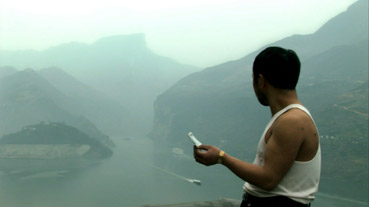
Still Life doesn't so much texture the background as make it a crucial aspect of the drama. That second observation above about the seeming lack of incident refers specifically to that plot outline, two relatively simple stories of questions, information and encounters. But by making the setting and situation as important a film character as his two protagonists, Jia loads every meeting, every conversation, every walk through the semi-surrealistic demolition zone, and every perfectly framed hilltop gaze with social relevance and subtle meaning. As someone who has never visited China and knows it only on a superficial and largely media-fed level, I freely admit that I did not initially recognise a fair proportion of the film's busy social substructure for what it is, but I responded to it nonetheless, absorbing its density in the way we do when visiting a distant country for the first time. One of the strengths of such layering and attention to small detail is that while it may indeed deepen the narrative, it also enriches the experience of watching it, a sensation enhanced by Zhangke's decision to shoot on video rather than film. I've no doubt this was governed in part by expedience, as the film was shot on location in the midst of actual demolition work for a very real and locally famous dam project. But the sense of documentary immediacy this creates, together with the naturalistic performances, also strips even carefully staged scenes of their artificiality, creating a very tangible sense of reality and location that allows us to discover this new place through Han and Shen Hong's eyes.
Their various encounters with others are telling, although not always in ways that are clear to those of us who are not steeped in Chinese culture, myself included. For example, Han's first meeting with ferry boat captain Ma, who through marriage to Han's ex-wife has become his brother-in-law, provokes a strangely hostile reaction on the ferryman's part, which is backed by the suggestion of threat when his crew arrive one by one to eat their lunch and glare suspiciously at this intruder. How one of them has suffered head injuries and why he comes close to physically assaulting Han is never explained (the commentary provides answers here), but the scene as a whole very effectively isolates Han as an outsider, a situation that eases when he is befriended by young wannabe gangster Brother Mark (one of a group that scammed him on his arrival), and when he finds work and genuine comradeship as a member of a local demolition crew.
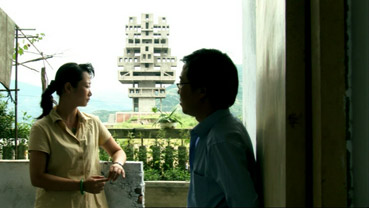
Information about our two protagonists unfolds in tandem with their progress in locating their absent partners. That Han's wife was effectively a mail-order bride whom he married when she was just sixteen is revealed through a casual chat with Brother Mark that takes place well into the first act, while Shen Hong's suspicions that her husband is having an affair are exposed in a seemingly offhand conversation she has with a worker whose head wound she dresses, an act of assistance that also informs us of her profession. It's here that you realise just how closely the two stories are mirroring each other, the similarity of quests echoed and sometimes directly contrasted by the individuals that the two leads encounter, and the manner in which information is revealed to them. Watch the film a second time and these connections really start to mount up, but such is their subtlety that you'll need that second viewing to appreciate them all.
I'll admit that my fourth observation regarding what I was learning about the new China was an uncertain one, and it took a listen to the commentary to confirm the actuality of elements that could easily have been artificially shaped for the camera, and made to look real through canny performance and handling. The locations are consistently extraordinary, with Fengjie gradually being reduced to rubble one building at a time, not by modern demolition machinery but low paid workers swinging sledge-hammers, the methods of the past used to make way for the technology of the present. Many of the encounters are small social stories in themselves: the heated arguments between aggrieved citizens and officials witnessed at the start of both stories; the middle-aged woman who offers her services as a prostitute because her husband is too ill to work; the 16-year-old girl who asks Shen Hong about becoming a maid in her home town; the workers who are offered a day's wage to beat up a tenant who refuses to move; the kid who steals cigarettes and sings heartfelt songs of love whose words can have no meaning for him; the young executive who enjoys a power kick by having his engineers switch on a blaze of bridge lights at his command to impress his VIP guests. Even Brother Mark's staged cool proves not to be the real deal but the result of an (apparently common) idolisation of actor Chow Yun Fat and his work in the action thrillers of John Woo.
It's this density of detail that makes Still Life so consistently fascinating, even if elements do pass you by on that first viewing, and I'll admit that even the second time around I remained unclear on a few points. The commentary makes a reasonable job of clarifying the four commodity chapter titles – Cigarettes, Liquor, Tea and Toffee – but no explanation is offered for the film's intermittent dips into outright surrealism involving a UFO, a tightrope walker, three Peking Opera players dressed as Gods of the Underworld, and a concrete monument that unexpectedly launches into space, a shot that was already remarkable for the strange sense of isolation created by a single hung-up item of clothing. They don't necessarily feel wrong for the film – the landscape itself is a semi-surrealist deconstruction of a city, after all – and all are striking moments in themselves, but do sit rather strangely with the documentary realism of the surrounding drama.
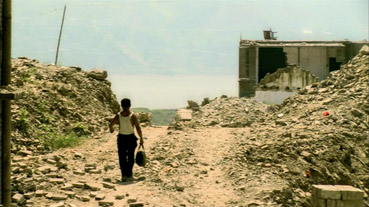
Viewer patience and attention is required, sure, but Still Life really does reward the effort. And yes, both stories do reach their separate conclusions, one of them surprising in a way that's likely to need that second viewing to review your understanding of what was unfolding in the build-up to it. Offering a quietly critical view of destruction of the traditional to make way for the modern but at the same time celebrating the spirit of the workers instrumental in making it happen, Still Life is a film of subtle and even sleight-of-hand density, and one that most effectively demonstrates that a thousand meaningful whispers are far more effective than a series of loud and directionless shouts.
I've been unable to nail down the exact format Still Life was shot on – some commentators have suggested that it's HD, but having worked with a variety of video formats, hi-def included, I'm not so sure, and suspect we're looking at mini-DV or DV-CAM, suggested by the slight softness on fine detail and burned-out highlights.* As I said in the main review, this look works well for the tone of the piece, giving it an immediacy that film, for all its pictorial superiority, can often put at a distance. Within these DV restrictions the transfer is a strong one, with the contrast consistently good within the DV range – there's a slight slight sepia tint to the picture that feels deliberate. Obviously dust and dirt are not an issue.
Like picture, the Dolby stereo 2.0 soundtrack has a here-and-now clarity that I tend to associate specifically with video. This adds to the abovementioned immediacy and really places you in the location, to the extent that a few of the background sounds were so vivid and specifically located on the sound stage that I was fooled into thinking they were coming from somewhere in the room.
English subtitles are included for the main feature, the accompanying documentary Dong, and – pleasingly – for the commentary track.
Commentary by Tony Rayns
Tony Rayns is a familiar voice (and occasionally face) on UK and US DVDs of Far Eastern films and with good reason. A renowned expert on the Asian cinema, he has also met and worked with some of the filmmakers whose work he comments on, including Jia Zhangke, whom he has known for eleven years and whom he assisted with the English subtitles on this very film. Rayns' commentaries are always a busy and worthwhile listen, but the one here is an essential and consistently fascinating companion to the film. As someone familiar with both Chinese culture and the director's intentions and working methods, Rayns fills in the gaps and illuminates the mysteries, providing a wealth of background detail on the film, the location, and the society in which it is set, as well as highlighting the many connections between the stories and the incidents that are specific to each. There's an argument, of course, to suggest that he is providing information that should have been communicated by the film itself, but that doesn't wash here – the film was made primarily with a Chinese audience in mind, one that would doubtless pick up on all those points we westerners are more likely to miss, and Rayns thus enables us to watch the film a second or third time from an insider's perspective in a way that enriches the film even further. An excellent inclusion.
Dong (67:34)
When the extras menu includes a documentary relating to the main feature, it's natural to expect a behind-the-scenes look at its making, which too often takes the form of a back-slapping EPK or a formless collection of grabbed footage of the cast and crew at work. What you don't expect to find is a film worthy of its own DVD release, but that's what you get here.
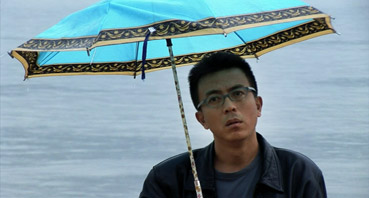
Dong is a documentary portrait of painter Liu Xiaodong made almost in tandem with Still Life, to which it is bonded by its style, character and location. It began when Jia was invited by Liu (the two are good friends) to film the creation of a portrait of a group of men from a demolition crew involved in clearing the way for the Three Gorges Dam. This was Jia's first visit to the district and proved an inspirational one, leading to the making of Still Life and the casting of several locals in key support roles, including the crew who were the subject of Liu's painting. In the second half, the painter travels to Bangkok to create wall-sized, multi-canvas picture of a group of young Thai women.
Although the construction of both artworks is covered, Jia is clearly more interested in their creator, the locations in which they are created, and the activities and people that surround them, the bright and noisy bustle of Bangkok contrasting starkly with the rainy-season serenity of the Three Gorges. This contrast extends to the all-male and all-female gender of the subjects Liu has selected for his paintings, which itself is reflected in the male and female protagonists of the two stories in Still Life. Side-stories are developed whose purpose only becomes clear as they unfold. – Liu's visit to the family of a recently deceased man to deliver presents and photographs, respectfully and touchingly observed by Jia's camera, has no formal introduction or voice-over, and only through conversation do we realise that the man was one of the demolition crew that Liu was painting and that he very likely died as the result of an accident at work. The similarity in style of the two films is such that it's impossible to be sure if the body being carried through the rubble for transportation to hospital is that of the worker or whether this is an unused shot from a similar incident in Still Life.
Intermittently, Liu discusses his work and his approach to art and life, revealing his fondness for Northern Wei Dynasty artwork and dismissing any suggestion that his paintings – which are impressive – should be taken all that seriously. "If you attempt to change anything with art it would be laughable," he comments late in the film. "Once in a while, they have a good time, that's it. I'm getting by, but, as long as I live, I have to express myself."
There are plenty of sometimes strikingly composed shots of Liu lost in contemplative thought, and just occasionally the camera moves in the manner of a dramatic feature (the dolly shot that slowly drifts in to follow a crouching demolition worker as he rises to stretch his legs, for example), but this is nicely balanced by the engagingly vérité moments in which Liu tries out his Thai pronunciation with locals and enjoys the exuberance of local café patrons, and the fourth wall temporarily crumbles when a shot of the van in which Liu is travelling is brought to a sudden halt after the vehicle from which Jia is filming collides with another.
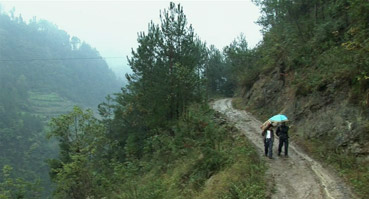
One of most intriguing diversions occurs late in the film's second half, when a break in the painting sees Jia's camera not follow Liu as expected but his model, as she rests, dresses, tries to call a friend, walks, and rides the bus home, watches a TV news report about flood damage, and then heads out for the evening. And it's certainly possible to read a message into the final sequence, in which two blind singing beggars make their way slowly through the crowds at a Bangkok market, where the vast majority of faces are those not of locals but western tourists.
Very much a companion piece to Still Life, Dong is a gentle, meditative but richly textured documentary portrait of an artist, his subjects, and the locations in which he works. Although a very different film, it reminded me at times of Wim Wenders' Tokyo-Ga, a documentary that also created a strong sense of its location by lingering on specific and sometimes unrelated places and moments. Unlike Wenders' film, however, Dong communicates the director's feel for his subject and location without need to explanatory titles or commentary, and does so in unwaveringly compelling fashion.
The picture here is anamorphic 1.85:1 and consistently good quality.
Booklet
As if the above weren't enough to quality the disc as a special edition, we also have another excellent BFI booklet to provide yet further insight into the film and its director. Included within are a Director's statement, a Chinese government outline of the Three Gorges dam project, an essay on Still Life by Chris Berry, an article the film by director Jia Zhanke, an interview with Zhangke by Stéphane Mas, a detailed and compelling article by Jia entitled Images That Cannot be Banned – New Cinema in China from 1995, a director's biography and filmography, the main credits for both films, and a good collection of stills.
Still Life is a film that the casual observer would find it easy to quickly lose interest in, but it is so richly textured and creates such a vivid sense of the surrealistic beauty of the location that a patient viewer should soon find themselves hooked on the characters' dual quests to locate their absent partners. Calling Dong an extra feature is almost doing a disservice to a film that would come recommended as a stand-alone release, while the Tony Rayns commentary and booklet are both essential companions to the main feature. Highly recommended.
|